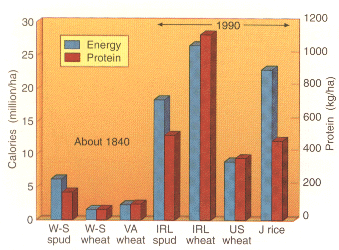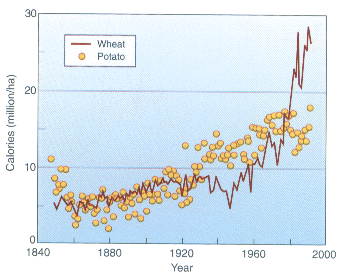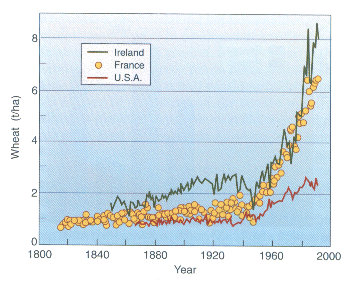




Next: Butin the End,
Up: Can Smarter Farming Spare
Previous: Smart farmers get more
Agronomists
take the eating habits of people as
fixed and given and raise the yields of the given crops.
Diets do change, however, as I have shown for the
United States. So going beyond raising the yields of
given crops by breeding and management, I shall
examine the ability of different species of plants to
spare more land for Nature by sustaining more people
on a given land area.
The title of Seeds of Change (Hobhouse, 1986[Hob86])
dramatizes
and the yardstick of agricultural progress in
Table B-1 in Appendix B measures how discoveries
and swapping of species during the Age of Exploration
revolutionized agriculture and humanity's diet.
The introduction of the potato into Ireland
exemplifies such change.
Although the tragedy of the Irish Famine
obscures
this fact, the potato helped the Irish greatly.
The potato, provided it did not fail, enabled great
quantities of food to be produced at a trifling cost
from a small plot of ground. Sub-division [of the
land] could never have taken place without the
potato: an acre and a half would provide a family
of four to six with food for twelve months,
while to grow the equivalent grain required an
acreage four to six times as large and some
knowledge of tillage as well. Only a spade was
needed for the primitive method of potato culture
usually practised in Ireland. Trenches were
dug and beds--called ``lazy beds"--made; the
potato sets were laid on the ground and earthed
up from the trenches; when the shoots appeared,
they were earthed up again. This method, regarded by
the English with contempt, was in fact admirably suited
to the moist soil of Ireland. (Woodham-Smith, 1980[WS80], 29-30; 35)
About 1780, the population of Ireland burgeoned, and
the rise from 1779 to 1841 has been placed at the astounding
figure of 179%. Woodham-Smith wrote that
first among the factors favoring the increase was ``an
abundant supply of incredibly cheap food, easily obtained,
in the potato, and the standard of living of the
time was such that a diet of potatoes was no great
hardship. With the addition of milk or buttermilk
potatoes form a scientifically satisfactory diet, as the
physique of the pre-famine Irish proved."
In 1841, the Irish numbered 8 to 9 million.
An Irish view in 1840 of a crop of the species
Solanum tuberosum compared with a crop of a cereal like
Triticum aestivum is reconstructed in Figure 7.5.1.
A family of five could be sustained on about 4 million
cal/yr. To produce the calories on an acre and one-half,
or 0.6 ha, as Woodham-Smith wrote, would require a yield
of 11 t/ha of potatoes containing 610 call
kg. A contemporary wrote in 1845 that Irishmen grew
5 t of potatoes on a rood, or 0.1 ha (Large, 1940[Lar40], 23),
but comparison with Woodham-Smith's report of 11
and modern yields less than 50 make the 1845 report
of 50 t/ha iffy.
 Figure 7.5.1. About 1840 and today, the calories and protein
grown per hectare. The crops about 1840 were
potato (spud) and wheat in Ireland reported by
Woodham-Smith (W-S) and in Virginia (VA) reported
by Jefferson. The 1990 yields were reported by FAO
for potato, wheat, and rice in Ireland (lRL), the
United States, and Japan (J) (Edwards, 1943; Food
and Agriculture Organization of the United Nations,
1992; Woodham-Smith, 1980). [Edw43][FotUN][WS80]
Figure 7.5.1. About 1840 and today, the calories and protein
grown per hectare. The crops about 1840 were
potato (spud) and wheat in Ireland reported by
Woodham-Smith (W-S) and in Virginia (VA) reported
by Jefferson. The 1990 yields were reported by FAO
for potato, wheat, and rice in Ireland (lRL), the
United States, and Japan (J) (Edwards, 1943; Food
and Agriculture Organization of the United Nations,
1992; Woodham-Smith, 1980). [Edw43][FotUN][WS80]
Woodham-Smith (1980[WS80]) wrote that compared with
potatoes, `` ...the equivalent grain required an acreage
four to six times as large." This implies a yield of
0.4 t/ha of wheat containing 3,300 callkg.
Thomas Jefferson's (Edwards, 1943[Edw43])
letters report
yields in Virginia during the same era. In 1793, he
wrote George Washington that small grain yielded
1.0 to 1.3 t/ha on good land. In 1795, Jefferson planted
a measured acre of wheat and in his farm book
recorded a yield of only 0.25 t/ha. In 1815, he modestly
wrote Jean Baptiste Say, ``Our best farmers
(such as Mr. Randolph, my son-in-law) get from [0.7
to 1.3 t/ha of wheat. ...Our worst (such as myself)
from [0.4 to 1.2i, with little or more manuring." (Later
I shall show that the average U.S. yield of wheat was 0.7 t/ha in 1869).
In his farm book in 1795, Jefferson
recorded the
respectable yield of 9 t/ha potatoes, near the 11 t/ha
I inferred from Woodham-Smith's report of 1840 Ireland.
In dry 1830, a farmer in Connecticut wrote that
3.4 t/ha was ``not half a crop" (Townshend, 1985[Tow85]).
The left of each pair of bars in Figure 7.5.1 depicts
the energy or calories, and the right the protein per
hectare. The height of the first pair of bars shows the
advantage of the Solanum spp. over wheat, whether
the Irish wheat estimated from Woodham-Smith's
words or the Virginia wheat reported by Jefferson.
Early in the nineteenth century, changing from grain
to potatoes either supported more Irish on a rood of
land or spared more roods for Nature.
Figure 7.5.1 also compares some modern crops. The
yields of energy and protein are calculated from national
average crop yields for 1990 (Food and Agriculture
Organization of the United Nations, 1992[FotUN]).
The great increase in productivity of potatoes in Ireland
fulfills expectations. The productivity of 72 thousand
ha of Irish wheat today, however, astounds. It
exceeds any other national average. Its energy yield
slightly exceeds that of the intensive crop of Japanese
rice, and because wheat is richer in protein than rice,
Irish wheat yields far more protein than does Japanese rice.
Yields in Virginia today also show the relative rise
in wheat compared with potato yields. In 1990, the
average yield of wheat in Virginia was about 10 times
Jefferson's 1795 yield on a measured acre, but the
1990 Virginia average for potatoes was only slightly
more than twice Jefferson's 1795 yield.
Even in the nineteenth century, wheat gained on
potato yields (Figure 7.5.2).
National statistics (Mitchell,
1980[Mit80]) beginning in 1847 show area and production
of wheat and potatoes in Ireland. Although these
statistics show wheat and potatoes producing somewhat
more calories than I inferred for Figure 7.5.1,
potatoes nevertheless out-yielded wheat in 1847. By
the end of the century, however, declining potato and
rising wheat yields put wheat in front for many years.
After falling behind, especially during World War II,
Irish wheat began producing more energy per hectare
than did Irish potatoes.
beginning in 1847 show area and production
of wheat and potatoes in Ireland. Although these
statistics show wheat and potatoes producing somewhat
more calories than I inferred for Figure 7.5.1,
potatoes nevertheless out-yielded wheat in 1847. By
the end of the century, however, declining potato and
rising wheat yields put wheat in front for many years.
After falling behind, especially during World War II,
Irish wheat began producing more energy per hectare
than did Irish potatoes.
 Figure 7.5.2. The changing advantages in
energy yield of Irish potatoes and wheat (Food and Agriculture
Organization of the United Nations, various years;
Mitchell, 1980). [FotUN][Mit80]
Figure 7.5.2. The changing advantages in
energy yield of Irish potatoes and wheat (Food and Agriculture
Organization of the United Nations, various years;
Mitchell, 1980). [FotUN][Mit80]
The yields of other crops, too, fail to rise like the
logistic curve in Figure 7.3.2. For example, the unchanging
yield of Japanese rice recently has been
emphasized (Holmes, 1993[Hol93]). The stubborn failure of
yields to rise dooms, of course, any sparing land for
Nature. In some cases, persistent research may succeed
in lifting the ceiling now holding down yields of
the species. In other cases, Figure 7.5.2 suggests
changing species may be the way to feed more people
without expanding cropland as population grows.
The change could, of course, be to a combination that
increased food production during a decade by multiplying
the number of crops per time or alleviating a
soil problem by rotation.
Changing crops can increase the number of people
supported
on a given cropland, and reversing the
change can increase the number again.
The poor showing in Figure 7.5.1 of the average of
the 28 million ha of modern American wheat makes
the point that environment as well as species affects
yield. In the nineteenth century, Irish wheat yielded
more than American (Figure 7.5.3.).
Although
yield of Irish wheat exceeded that of French in the
mid-nineteenth century, both increased somewhat
and both exceeded that of American wheat by the end
of the century. During the twentieth century, the gap
between wheat yields in the two European nations
and in the United States widened. Although farmers
in some places in the United States grew high yields,
weather held back others. Among the 50 United
States and their diverse weather, average wheat
yields varied almost fourfold in 1990. Environment,
especially the unreliability of water in the American
Wheat Belt, as well as species, affects yield.
 Figure 7.5.3. The course of wheat yields in Ireland, France, and
the United States (Edwards, 1943; Food and
Agriculture Organization of the United Nations, 1992;
Mitchell, 1980;
Woodham-Smith, 1980). [Edw43][Mit80][FotUN][WS80]
Figure 7.5.3. The course of wheat yields in Ireland, France, and
the United States (Edwards, 1943; Food and
Agriculture Organization of the United Nations, 1992;
Mitchell, 1980;
Woodham-Smith, 1980). [Edw43][Mit80][FotUN][WS80]
In wet western Ireland, potato varieties of 1840 in
lazy-beds beat grain, but for the national average, the
wheat of 1990 beat modern potatoes. In America, likely because water
limits wheat yields, the recent rise
in wheat yields has been smaller than in Ireland. So
changing human diets and crop species to match the
era and place can increase the number of people sustained
on a given area of land, saving more for Nature.





Next: Butin the End,
Up: Can Smarter Farming Spare
Previous: Smart farmers get more
Yasuko Kitajima
Thu Jun 19 16:20:56 PDT 1997
 Figure 7.5.1. About 1840 and today, the calories and protein
grown per hectare. The crops about 1840 were
potato (spud) and wheat in Ireland reported by
Woodham-Smith (W-S) and in Virginia (VA) reported
by Jefferson. The 1990 yields were reported by FAO
for potato, wheat, and rice in Ireland (lRL), the
United States, and Japan (J) (Edwards, 1943; Food
and Agriculture Organization of the United Nations,
1992; Woodham-Smith, 1980). [Edw43][FotUN][WS80]
Figure 7.5.1. About 1840 and today, the calories and protein
grown per hectare. The crops about 1840 were
potato (spud) and wheat in Ireland reported by
Woodham-Smith (W-S) and in Virginia (VA) reported
by Jefferson. The 1990 yields were reported by FAO
for potato, wheat, and rice in Ireland (lRL), the
United States, and Japan (J) (Edwards, 1943; Food
and Agriculture Organization of the United Nations,
1992; Woodham-Smith, 1980). [Edw43][FotUN][WS80]
 Figure 7.5.2. The changing advantages in
energy yield of Irish potatoes and wheat (Food and Agriculture
Organization of the United Nations, various years;
Mitchell, 1980). [
Figure 7.5.2. The changing advantages in
energy yield of Irish potatoes and wheat (Food and Agriculture
Organization of the United Nations, various years;
Mitchell, 1980). [ Figure 7.5.3. The course of wheat yields in Ireland, France, and
the United States (Edwards, 1943; Food and
Agriculture Organization of the United Nations, 1992;
Mitchell, 1980;
Woodham-Smith, 1980). [
Figure 7.5.3. The course of wheat yields in Ireland, France, and
the United States (Edwards, 1943; Food and
Agriculture Organization of the United Nations, 1992;
Mitchell, 1980;
Woodham-Smith, 1980). [